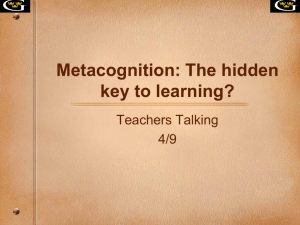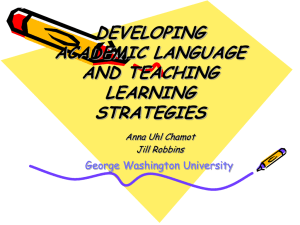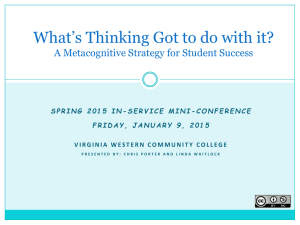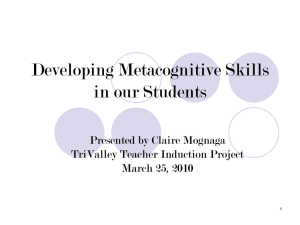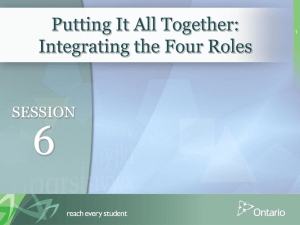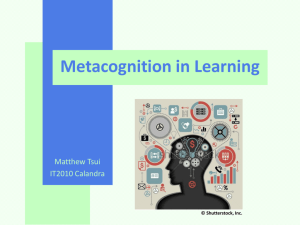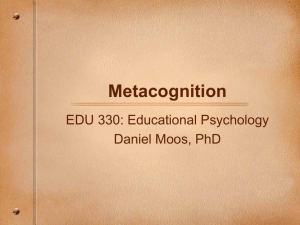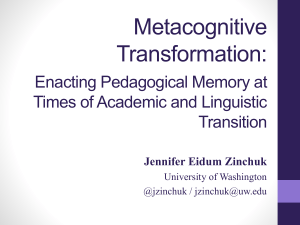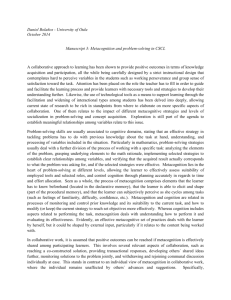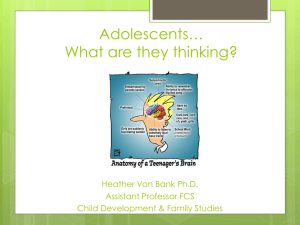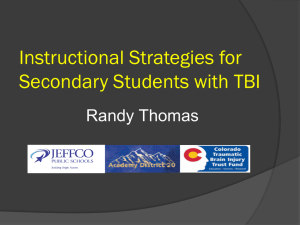Three Tools for Promoting Metacognition
advertisement
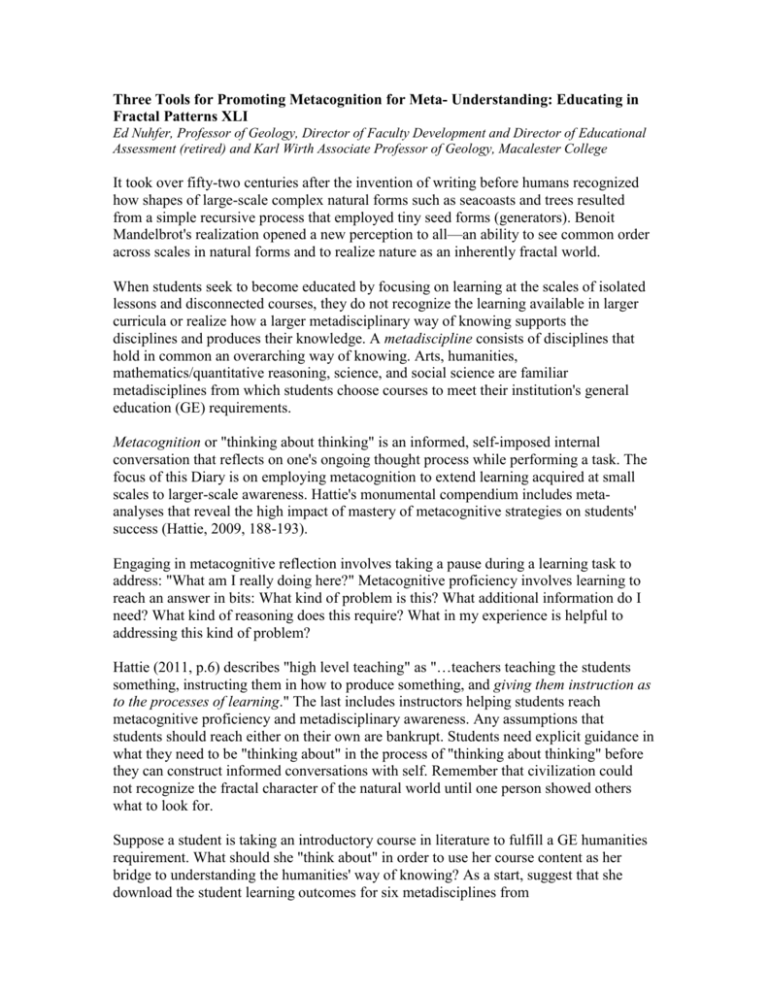
Three Tools for Promoting Metacognition for Meta- Understanding: Educating in Fractal Patterns XLI Ed Nuhfer, Professor of Geology, Director of Faculty Development and Director of Educational Assessment (retired) and Karl Wirth Associate Professor of Geology, Macalester College It took over fifty-two centuries after the invention of writing before humans recognized how shapes of large-scale complex natural forms such as seacoasts and trees resulted from a simple recursive process that employed tiny seed forms (generators). Benoit Mandelbrot's realization opened a new perception to all—an ability to see common order across scales in natural forms and to realize nature as an inherently fractal world. When students seek to become educated by focusing on learning at the scales of isolated lessons and disconnected courses, they do not recognize the learning available in larger curricula or realize how a larger metadisciplinary way of knowing supports the disciplines and produces their knowledge. A metadiscipline consists of disciplines that hold in common an overarching way of knowing. Arts, humanities, mathematics/quantitative reasoning, science, and social science are familiar metadisciplines from which students choose courses to meet their institution's general education (GE) requirements. Metacognition or "thinking about thinking" is an informed, self-imposed internal conversation that reflects on one's ongoing thought process while performing a task. The focus of this Diary is on employing metacognition to extend learning acquired at small scales to larger-scale awareness. Hattie's monumental compendium includes metaanalyses that reveal the high impact of mastery of metacognitive strategies on students' success (Hattie, 2009, 188-193). Engaging in metacognitive reflection involves taking a pause during a learning task to address: "What am I really doing here?" Metacognitive proficiency involves learning to reach an answer in bits: What kind of problem is this? What additional information do I need? What kind of reasoning does this require? What in my experience is helpful to addressing this kind of problem? Hattie (2011, p.6) describes "high level teaching" as "…teachers teaching the students something, instructing them in how to produce something, and giving them instruction as to the processes of learning." The last includes instructors helping students reach metacognitive proficiency and metadisciplinary awareness. Any assumptions that students should reach either on their own are bankrupt. Students need explicit guidance in what they need to be "thinking about" in the process of "thinking about thinking" before they can construct informed conversations with self. Remember that civilization could not recognize the fractal character of the natural world until one person showed others what to look for. Suppose a student is taking an introductory course in literature to fulfill a GE humanities requirement. What should she "think about" in order to use her course content as her bridge to understanding the humanities' way of knowing? As a start, suggest that she download the student learning outcomes for six metadisciplines from http://profcamp.tripod.com/metadoutcomeslist.pdf and reflect on how her course exemplifies any of the humanities outcomes. Next, consider employing one of the following three tools for guiding thinking toward reaching larger-scale outcomes. 1. Learning-across-the curriculum modules (NTLFV20N4 8-11) These offer a direct approach for initiating students in any discipline into metacognition. Our example module comes from research that revealed how successful higher education advances adults' capacity to think in a known sequence of stages (Table 1). Download the module from http://profcamp.tripod.com/module12metacog.rtf and try going through it yourself. The citations on adult intellectual development are in the module. Table 1: A Summary of Stages of Adult Intellectual Development (Perry Model) Stage 1 & 2 thinkers believe that all problems have right and wrong answers, that all answers can be furnished by authority (usually the teacher), and that ambiguity is a needless nuisance that obstructs getting at right answers. Stage 3 thinkers realize that authority is fallible and does not have good answers for all questions. Thinkers at this stage respond by concluding that all opinions are equally valid and that arguments are just about proponents' thinking differently. Evidence to the contrary does not change this response. Stage 4 thinkers recognize that not all challenges have right or wrong answers, but they do not yet recognize frameworks through which to resolve how evidence best supports one among several competing arguments. Stage 5 thinkers can use evidence. They also accept that evaluations that lead to best solutions can be relative to the context of the situation within which a problem occurs. Stage 6 thinkers appreciate ambiguity as a legitimate quality of many issues. They can use evidence to explore alternatives. They recognize that the most reasonable answers often depend upon both context and value systems. Stages 7, 8 and 9 thinkers incorporate metacognitive reflection in their reasoning, and they increasingly perceive how their personal values act alongside context and evidence to influence chosen decisions and actions. To acquire higher order thinking requires intentional work over several years, so we introduce this module in our freshman courses, and we continue to engage students with it through higher-level courses. Students need a map to intentional intellectual development, and they can get it by learning the characteristics of higher order thinking, the sequence in which these appear, discovering their current stage of development, and then considering how to reach for the next stage. Knowledge surveys (NTLFV15N6 p11; V15N4 p8-11) Each item on a knowledge survey poses a challenge and asks students to self-assess their ability to engage it successfully on a three-point scale from zero (low-ability) to two (high-ability). See the site at http://www.merlot.org/merlot/viewMaterial.htm?id=437918 for tutorials, downloadable references, and examples. Self-assessment is a metacognitive skill. It involves accurately perceiving the degree of proficiency that one currently possesses. Hattie (2009, p 39 - 43) found present understanding of level of achievement as the most significant attribute of students for meeting their future goals. Skillful use of knowledge surveys involves structuring frequent opportunities for students to engage in selfassessments on banks of items and then compare these with their actual performances on quizzes and assignments. Three examples of knowledge survey items from introductory GE courses in geology reveal the versatility of the instrument to direct students' thinking to scales beyond lesson content. Placing these items in the knowledge survey prompts us not to forget to engage students with them. A prompt can trigger self-assessment of disciplinary course content knowledge: I can explain why it was necessary to first understand the principles of original horizontality, superposition, and crosscutting relationships before scientists could begin to derive the theory of plate tectonics. Items can just as easily engage students in the larger-scale metadisciplinary understanding of the nature of science that these science courses are supposed to address in supporting the GE curriculum. I can employ examples to illustrate key differences between the ways of knowing of science and of technology. An item can draw students to reconsider the stages of intellectual development from the learning module described above. My friend tells me: "Because everyone has a right to his or her opinion, we respect others by accepting tall opinions as equally valid.” I can recognize the stage of intellectual development revealed by that statement. Some programs employ learning documents, which are reference documents used to deliver a co-curriculum in how to learn while majoring in the discipline (NTLFV17N6 910). Download one from http://www.macalester.edu/geology/wirth/CourseMaterials.html. The course knowledge surveys in these programs carry items drawn from the learning documents. Often, knowledge surveys of about 150 such items given at the start of a course cause students to exclaim something like: "Good heavens! Will we to be able to learn ALL this?" However, by end of a well-taught course, nearly all recognize how much they gained from every item. Most will compare their own pre- and post- course results and realize: "I really did learn that much." Verified gain supports self-assessment's related metacognitive cousin, self-efficacy—the degree of proficiency that one believes one can attain with instruction and support. Alfred Bandura established self-efficacy as one of the most important predictors of student success (see V18N6 p12 and www.des.emory.edu/mfp/self-efficacy.htm). Reflective Learning Journals Reflective learning journals offer a valuable addition to any course for developing metacognitive reflection. Employing a common format evaluated with a common rubric, and giving the exercise repeatedly (between four and six completed journal submissions in a course) gives the necessary practice required to develop measurable proficiency. One version (Table 2) employs five components. We format the components together with a guiding rubric to make a "help sheet." Download it from http://profcamp.tripod.com/rljhelpsheet.rtf. Table 2. Components of a Reflective Learning Journal and What They Do Component 1. Summarize your assumptions, beliefs, understanding that you had when you first encountered the topic assigned here, before you started to engage it during learning it in this course. 2. Disclose new vocabulary that you acquired during your study of this topic. Include vocabulary that you may have acquired as part of your process in items 4-6 below. 3. Discover and describe connections that you can make between the topic and several other class sessions, exercises, readings, homework. Note in SPECIFICS what you found from making these connections that informed or expanded your understanding of the topic. Be sure to note how this learning is relevant to one or more of the published learning outcomes for the course. Refer to the specific outcome(s). 4. So as avoid depending on materials given to you in class, take action on your own behalf by looking to other resources. To provides evidence of this learning, describe IN SPECIFICS what you learned and from what source(s). 5. Close the loop" by comparing what you knew in #1 against what you know now. Metacognitive enhancement 1. Assessing what one thinks at the start of a task is a common theme in metacognition. A free writing exercise given at the introduction of a new topic is ideal for helping students capture their baseline knowledge and archive that for later use in a journal entry. 2. Building vocabulary increases reading comprehension and personal ability to access information. 3. Metacognitive reflection uncovers connections that are otherwise difficult to access. Practice in seeking connections between lessons and larger ideas is immensely valuable. 4. Assigning students to go beyond what authority (instructors) offers them moves beginning students to higher-level stages of thinking. Metacognition trains independent thinking. 5. Seeing one's growth affirmed builds selfefficacy. Our students at minimum should understand the differences between gaining knowledge, skill, capacity for thinking/reasoning, and metacognition (all recently addressed in NTLFV23N2p7-11). In addition, they should distinguish different kinds of understanding provided at the different scales of lessons courses, or the curricula of majors and degrees. Reference Hattie, J. (2009). Visible Learning: A Synthesis of over 800 Meta-Analyses Relating to Achievement. New York, New York: Routledge. For continued learning about metacognition, we recommend that readers enroll at the Improve with Metacognition site at http://www.improvewithmetacognition.com/2014/07/.
